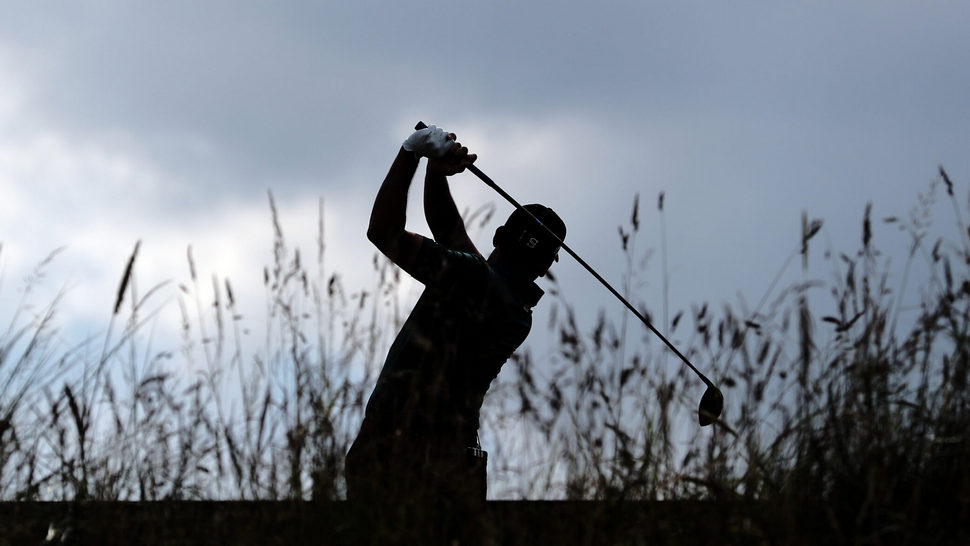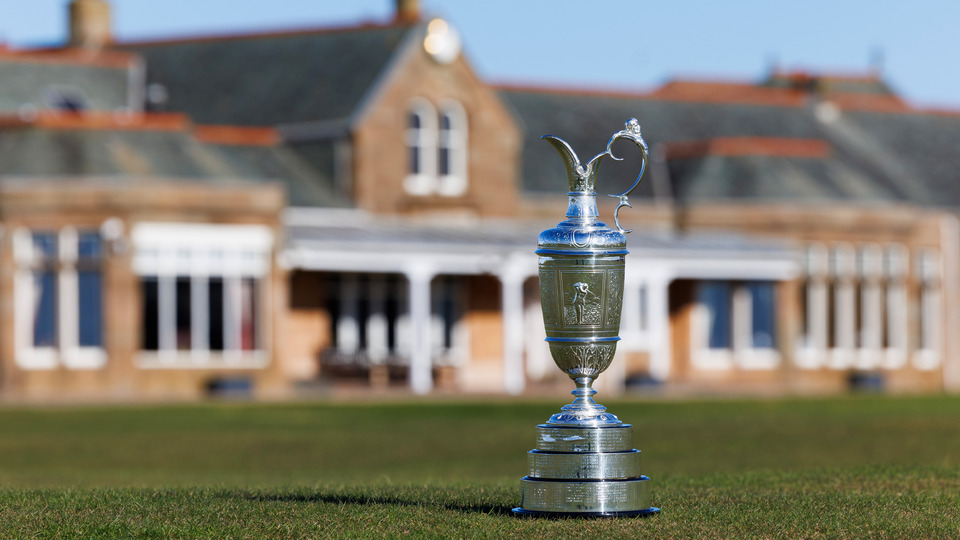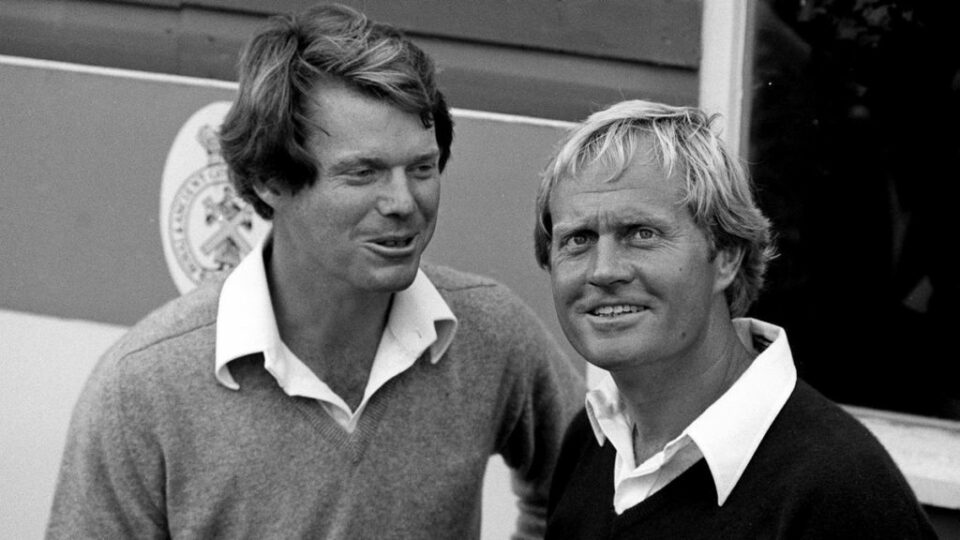Instruction
Can you feel this?
Nick Bradley is the best-selling author of the award-winning instruction books The 7 Laws of the Golf Swing and Kinetic Golf. One of the game's most original and creative thinkers, Nick has coached players to victory on both the European and PGA Tour (along with seven national amateur champions) and that experience has this season made him a valuable new addition to the Sky Sports’ team as a technical analyst and commentator. Earlier this year Nick took up the position of Director of The Reynolds Kingdom of Golf presented by TaylorMade at Reynolds Lake Oconee, an hour or so east of Atlanta, a facility previously only available to tour professionals. We look forward to bringing you an exclusive interview with Nick ahead of the Open at Carnoustie, not to mention further instruction shot at one of America’s most comprehensive coaching facilities. In the meantime, sit back and enjoy more creative golf courtesy of these mind-blowing visuals…
By Nick Bradley
Illustrations by Lee J. Rouse

Quick Tip
Get yourself a good elastic resistance band and use this exercise to engage the lateral muscles in your core as you wind up, creating this swing radius with your left arm
Use a resistance band (Or a snake!)
Feel the dynamics of swing & create a controlling left arm radiusThe message I want to get across – particularly to those of you prone to the ‘reverse pivot’, raising the right hip and falling onto the left side – is that you want the feeling of the upper body being pulled to the right while the lower body is pulled to the left. You need that disassociation between your mid-thigh and mid-rib – that will improve your backswing pivot and coil.
This snake image is a bit of fun...but there’s a serious point to be made here in regard to creating coil and the importance of getting the radius of your arm-swing to work with the rotation of your body – and to do that you have to get the butt-end of the club working away from that left foot. A great drill here is to get a resistance band, hook one end under the toe of your left foot, hold the other under your left hand grip and stretch to this position as you rehearse your backswing. To wind up correctly you simply have to engage the lateral muscles in your body – and if you hold this position momentarily you’ll feel the burn down the left side of your torso. Regular training with a resistance band will accelerate your improvement and give you a better, stronger and more consistent backswing position.
Quick swing fix
Three points of resistanceWhen you work with tour players you often encounter a balance issue – and I’m not talking about anything to do with the actual golf swing. When I write this, Padraig Harrington springs to mind; a player who always has to monitor the balance between being too technical and too flowing.
Too technical and the player loses all feel for the shot, distance control and the ability to outwardly strategise. Too flowing and the discipline of motion goes out the window. We have to accept that great golf demands both of these qualities in equal measure – in other words you have to be the mechanic and the driver.
The image here is created for the golfer who has lost discipline in first, the body, and, subsequently, the club. Since the master of the club is the body, it is the body we must look to first if things are going haywire. The three points I refer to are the head (spine), and the two knees. Look at any great player over the years and you will not see a lot of movement in these areas, they have always held court and let everything else work around them and their disciplined movement.

Credit - Lee J. Rouse
So, when you are looking for a starting point, either for a regular check up or to correct something niggling you in your swing, go back to these fundamentals and focus on the discipline of motion a steady head and two steady knees are giving you...they hold more authority in your swing than you know!
If you look at the great golf swings over the years – take your pick from Hogan, Nicklaus, Faldo, McIlroy – you can identify what biomechanics gurus would describe as ‘disassociation’ between the lower and upper body as the player reaches the top of his backswing. What do I mean by that? Well, the graphics on the illustration explain the principle: the rotation of the torso (maintaining those three points of resistance) creates this wedge-shape between the left hip and the upper body as the coil is created; the swing is loaded up and the rotation of the torso has been made against the resistance of the hips, thighs and knees.
The Strike
Understand how to release the right arm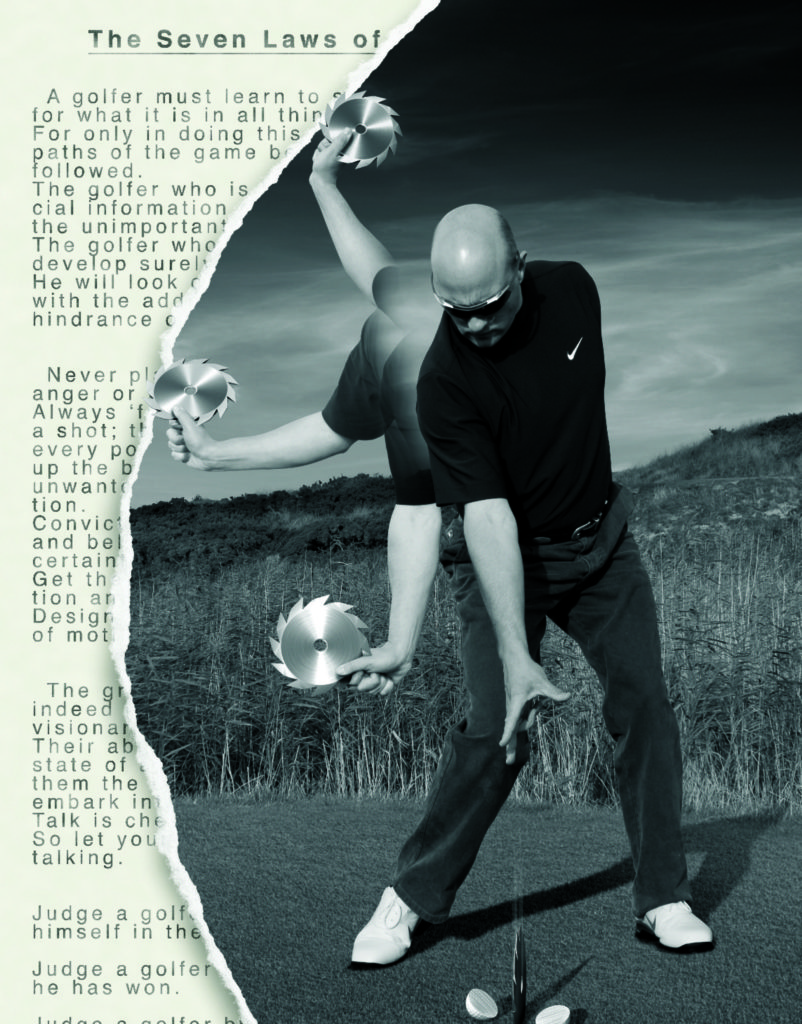
Credit - Lee J. Rouse
The right arm can be a nemesis for both the good player and the weekend slicer. For the hooker and pusher of the ball the right arm gets stuck behind the body turn on the way down causing it to approach the ball from a path that is too far from the inside. For the slicer the right arm becomes tight and immobile during the downswing and as the body unwinds left so does the trailing and out-of-sync right arm. In both cases the right arm needs to be trained to release better. As you can see from the image, to promote this essential release to the swing, you must visualise that the right arm is at its maximum length as the clubhead meets the ball. This isn’t to say the right wrist has fully released but certainly the arm should have felt that it’s done so. Liken this to a bow and arrow: once you have stretched the bow back what do you then do? You release it fully. You wouldn’t draw back the arrow, release the bow and then suddenly restrict it from catapulting the arrow forwards. Your swing works in exactly the same way....draw it back....let it go.
Drill : Sidehill Lie
Think baseball swing for a shallow, round-the-body action
Credit - Lee J. Rouse
Quick Tip
Imagine you are swinging a baseball bat...and guess what? You make a shallow, rotary motion with the club – perfect for dealing with a ball above your feet
The illustration you see here is one that I designed to help golfers get a good mental image for playing a sidehill lie with the ball positioned several inches above the level of the feet (and practising from this sort of position is highly recommended for all golfers with a tendency to slice...). Here, the mentality is that you have to shallow out your swing plane in order to nip the ball off the turf – you don’t want to be playing these shots with anything resembling a steep swing. The baseball analogy helps a golfer to visualise this rounded motion. In fact, when you encounter a sidehill lie I advise making practice swings holding the club out like a baseball bat and making that around-the-body swing. Keep your lower body action as ‘quiet’ as you possibly can and focus on rotating your shoulders and torso back and through, back and through . The more you shallow your swing the better you will get at picking the ball off the grass and flighting it with a lovely right-to-left draw shape. To further improve the quality of that strike, picture the ball sitting on top of a cluster of eggs in a basket and make it your goal to pick it off cleanly. Practising with the ball a few inches above the level of your feet is a really great exercise for everyone prone to a slice, as it very quickly improves the rotary motion of your body to which you can blend this compact and complementary arm-swing. I know a lot of tour players who practice this way – it will do your game good, too.
Hang back and hit it!
For solid strike, head stays behind the ball as you release driver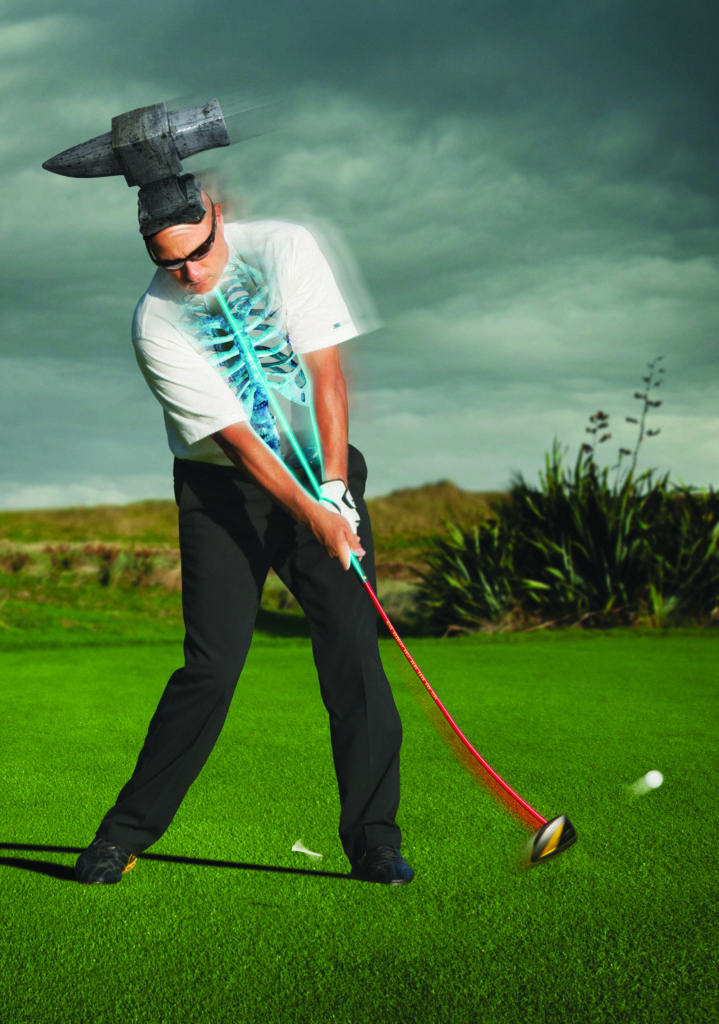
Credit - Lee J. Rouse
Quick Tip
A feeling of staying behind the ball as you unwind and release the club through impact will help you to improve your launch angle and hit longer drives
When I did the picture you see here for my book Kinetic Golf, so fed up was I with the rubbish talked about in ‘stack and tilt’ I wanted to make a point. It’s very dangerous, to my mind, to think about every golf swing as being ‘on top of the ball’. Fine when you’re hitting the short irons, but as you move through the scale towards the driver you want to create the situation where as you rotate you stay behind the ball and ‘fire’. Think about the great drivers of the ball – Jack Nicklaus and Greg Norman being two of the all-time greats. Their launch angle wasn’t 13 degrees, it seemed like 45 degrees! I remember watching them go head-to-head in the World Match Play at Wentworth back in the mid 1980s and I was blown away by the launch of the ball and the distance these guys hit it – and we’re talking persimmon and balata here, not titanium and a bullet. For 99.9% of the golfing population, I would say that keeping this visual in mind will help performance off the tee. Create this spine tilt at the set-up, wind up your swing and then keep your head behind the ball as you unwind and release the club at maximum speed. Send that ball into orbit. Rickie Fowler is a good role model here – he has the movement going on and he really stays behind it well, allowing the right shoulder to power through and around to the finish.Spin the wheel
The satisfying art of pitching
No, not the dreaded spinning spectrum you see on your Mac when you are about to lose an important file…though we’ve all been there! This is simply a visual to use when it comes to striking your pitch shots with a style and conviction that generates backspin, enabling you to control trajectory and dance the ball around the pin. I remember talking to Nick Faldo about the way he would imagine there was a small piece of sand-paper on the face of his wedges, and how he would then go after the sensation of ripping the paper under the ball with his wedge shots to generate spin. That’s a great visual to have in mind, well worth a try. This one will also help you: imagine you are setting up to one of those multi-coloured beach balls, and that you are going to impart a spin to strike it in such a way that it is going to set spinning the moment it leaves the clubface. There are a few critical factors to consider whenever you're looking to spin the ball with loft – the most important being speed. I want you to consider two technical elements here: The first is that I always like to see elite golfers play these shots with a fairly shallow angle of attack through the ball. I’m not a fan of
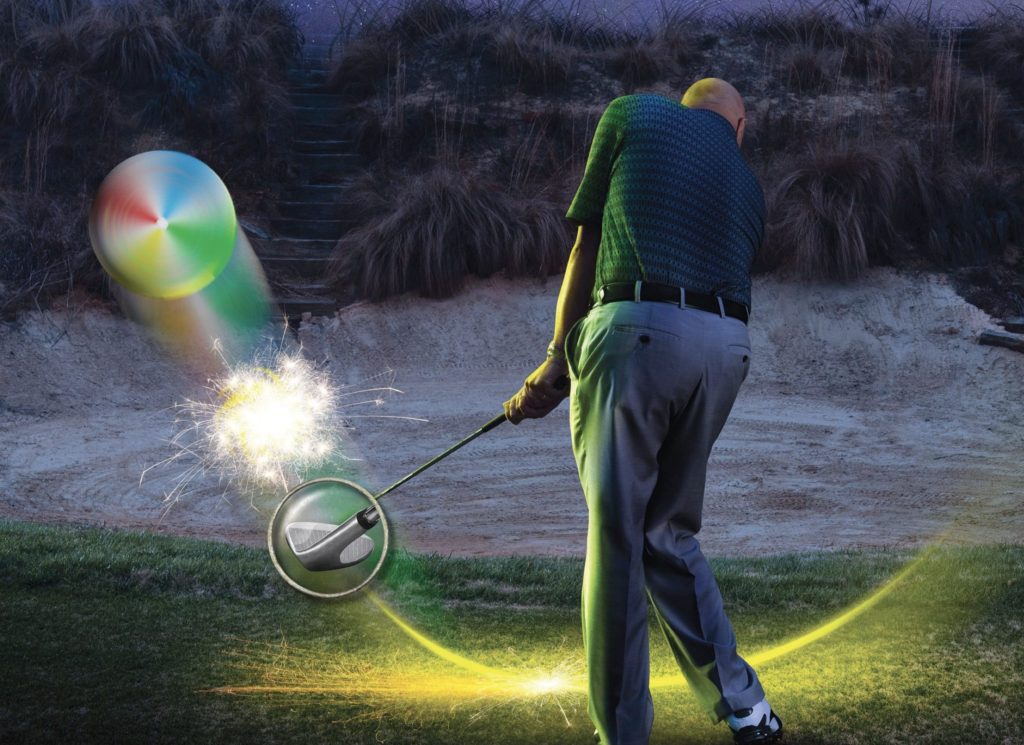
Credit - Lee J. Rouse
Quick Tip
Experiment with different release ‘feels’ to create the spin and flight of pitch shots to suit any given situation...
swinging down steeply and gouging huge divots. The second is the exclusion of a pronounced wrist cock on the way back. Most amateurs would be better off playing the spinning wedge shot with a wider and less ‘hingey’ backswing, thus eliminating a number of variables which lead to inconsistency of strike. So I want you to sense that you have ‘dead’ hands when playing this shot. If you were to spin the colours of the beach ball quickly, which is what we want to with a spinning wedge, you wouldn’t bash into the equator of the ball hitting directly into its core – no, you’d aim to clip the underside of the ball with speed and have those colours blur with velocity. For the more advanced players among you, go out there and feel that you zip your hands and the clubhead at speed, working from a wide backswing position to a narrow finish. Spin the cover, not the core. Start from wide to wide and then when you get that down start to experiment a little with release feels and patterns through the ball to work shots with varying spin and trajectory.
You can follow Nick Bradley on twitter @thenickbradley
Nick Bradley material supplied courtesy of Atlantic Golf & LifeStyle magazine
